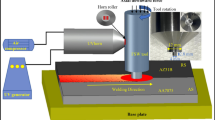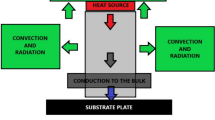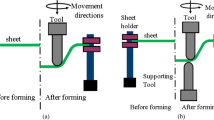Abstract
In the present work, a novel process of friction stir–assisted incremental forming with synchronous bonding of dissimilar sheet metals DC05 and AA5052-H32 has been conducted. The separate dissimilar sheet layers are bonded together to become a laminate sheet with a part simultaneously fabricated by incremental forming. Since the temperature level is a great concern to affect the formability, an analytical heat generation and transfer model is established for temperature prediction combined with different process parameters. Iterative formulae are implemented and the numerical results are obtained to reflect the evolution of maximum temperature during the whole processing period. It is found that larger step down, rotational speed, and forming angle with lower feeding rate will significantly cause higher process temperature, which proves that the proposed model satisfies the need of a prior of the process window. Micro IMC distribution is experimentally measured at different positions to verify the effect of temperature, which also shows good applicability. The proposed temperature prediction model is also valuable for other incremental sheet forming processes with high-speed tool rotation.










Similar content being viewed by others
Abbreviations
- A ij :
-
Circumferential area of loop (mm2)
- S ij :
-
Meridian cross-sectional area of loop (mm2)
- μ :
-
Coefficient of friction
- T pj :
-
Temperature of the tool during a loop (°C)
- N :
-
Number of node
- j:
-
Index of loops
- i:
-
Index of nodes in circumferential direction
- k:
-
Index of elements on a loop
- Δz :
-
Depth of step down (mm)
- Κ m :
-
Thermal conductivity of material (W/(mm K))
- Q ij :
-
Heat generated by friction and deformation (J)
- Q rotate :
-
Heat generated by rotation (J)
- T r :
-
Room temperature (°C)
- N k :
-
Iterative times for a loop
- \( {\mathrm{d}}_{i{i}^{\hbox{'}}} \) :
-
Distance between two loops (mm)
- rp :
-
Tool radius (mm)
- tj :
-
Time for performing a loop (s)
- \( \overline{\sigma} \) :
-
Equivalent stress (MPa)
- hf :
-
Final height of sheet (mm)
- t0 :
-
Initial sheet thickness (mm)
- σ s :
-
Yield stress (MPa)
- δ :
-
Percent of energy transformation
- β :
-
Forming angle (°)
- C m :
-
Specific heat of material (J/(g K))
- Κ p :
-
Thermal conductivity of tool (W/(mm K))
- ΔT ij :
-
Temperature variation for a node in a loop (°C)
- Δtj :
-
Iterative time for a loop (s)
- T melt :
-
Melting temperature (°C)
- rij :
-
Radius of a loop (mm)
- \( {\mathrm{q}}_{{{}_{ii}}^{\prime}}^j \) :
-
Heat flow between two nodes in a loop (J)
References
Kleiner M, Geiger M, Klaus A (2003) Manufacturing of lightweight components by metal forming. Ann CIRP 52(2):521–542
Jindal V, Srivastava V (2008) Growth of intermetallic layer at roll bonded IF-steel/aluminum interface. J Mater Process Technol 195(1–3):88–93
Zhang G, Su W, Zhang J, Wei Z (2011) Friction stir brazing: a novel process for fabricating Al/steel layered composite and for dissimilar joining of Al to steel. Metal Mater Trans A 42(9):2850–2861
Rest C, Jacques PJ, Simar A (2014) On the joining of steel and aluminium by means of a new friction melt bonding process. Scripta Mater 77:25–28
Cui S, Chen ZW, Robson JD (2010) A model relating tool torque and its associated power and specific energy to rotation and forward speeds during friction stir welding/processing. Int J Mach Tools Manuf 50(12):1023–1030
Yılmaz M, Çöl M, Acet M (2002) Interface properties of aluminum/steel friction-welded components. Mater Charact 49(5):421–429
Wang J, Lu F, Carlson BE, Sigler DR (2015) Analysis of Al-steel resistance spot welding process by developing a fully coupled multi-physics simulation model. Int J Heat Mass Transf 89:1061–1072
Jawale K, Duarte JF, Reis A, Silva MB (2018) Characterizing fracture forming limit and shear fracture forming limit for sheet metals. J Mater Process Technol 255:886–897
Assempour A, Nejadkhaki HK, Hashemi R (2010) Forming limit diagrams with the existence of through thickness normal stress. Comput Mater Sci 48(3):504–508
Cai S, Wu RH, Wang ZH, Li M, Chen J (2019) Coupled thermo-mechanical modeling of friction stir assisted incremental forming with synchronous bonding of heterogeneous sheet metals. Int J Adv Manuf Technol 106:2747–2763. https://doi.org/10.1007/s00170-019-04792-x
Li W, Li J, Zhang Z, Gao D, Wang W, Dong C (2014) Improving mechanical properties of pinless friction stir spot welded joints by eliminating hook defect. Mater Des 62(10):247–254
Hamilton K, Jeswiet J (2010) Single point incremental forming at high feed rates and rotational speeds: surface and structural consequences. CIRP Ann Manuf Technol 59(1):311–314
Yu Z, Wei Z, Choo H (2012) Transient heat and material flow modeling of friction stir processing of magnesium alloy using threaded tool. Metal Mater Trans A 43(2):724–737
Giuseppina A, Claudio C, Luigino F, Francesco G (2016) Theoretical model for temperature prediction in incremental sheet forming – experimental validation. Int J Mech Sci 108-109:39–48
Macdougall D (2000) Determination of the plastic work converted to heat using radiometry. Exp Mech 40(3):298–306
Cheon J, Yoon JY, Kim C, Na SJ (2018) A study on transient flow characteristic in friction stir welding with real-time interface tracking by direct surface calculation. J Mater Process Technol 255:621–634
Lu B, Fang Y, Xu DK, Chen J, Ai S, Long H, Ou H, Cao J (2015) Investigation of material deformation mechanism in double side incremental sheet forming. Int J Mach Tools Manuf 93:37–48
Hmida RB, Thibaud S, Gilbin A, Richard F (2013) Influence of the initial grain size in single point incremental forming process for thin sheets metal and microparts: experimental investigations. Mater Des 45(6):155–165
Leon MD, Shin HS (2015) Material flow behaviours during friction stir spot welding of lightweight alloys using pin and pinless tools. Sci Technol Weld Join 21(2):140–146
Jóźwiak S, Karczewski K, Bojar Z (2010) Kinetics of reactions in FeAl synthesis studied by the DTA technique and JMA model. Intermetallics 18(7):1332–1337
Nandan R, Debroy T, Bhadeshia HKDH (2008) Recent advances in friction-stir welding – process, weldment structure and properties. Prog Mater Sci 53(6):980–1023
Wan L, Huang Y (2018) Friction stir welding of dissimilar aluminum alloys and steels: a review. Int J Adv Manuf Technol 99(5–8):1781–1811
Yahiro TM, Yoshida T, Doi D (1990) Development of nonferrous clad plate and sheet by warm rolling with different temperature of materials. ISIJ Int 31(6):647–654
Kobayashi S, Yakou T (2002) Control of intermetallic compound layers at interface between steel and aluminum by diffusion-treatment. Mater Sci Eng A 338(1):44–53
Jindal V, Srivastava VC (2008) Growth of intermetallic layer at roll bonded IF-steel/aluminum interface. J Mater Process Technol 195(1):88–93
Funding
This study was financially supported by the National Natural Science Foundation of China (NSFC) under grant no. 51675332 and Program of Shanghai Excellent Academic Research Leadership (19XD1401900).
Author information
Authors and Affiliations
Corresponding author
Additional information
Publisher’s note
Springer Nature remains neutral with regard to jurisdictional claims in published maps and institutional affiliations.
Rights and permissions
About this article
Cite this article
Wu, R., Li, M., Cai, S. et al. Analytical model for temperature prediction in friction stir–assisted incremental forming with synchronous bonding of dissimilar sheet metals. Int J Adv Manuf Technol 107, 2177–2187 (2020). https://doi.org/10.1007/s00170-020-05144-w
Received:
Accepted:
Published:
Issue Date:
DOI: https://doi.org/10.1007/s00170-020-05144-w




